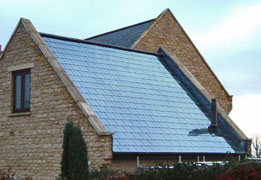Solar Thermal Collectors
There are five types of Solar Thermal Collectors:
Flat Plate Solar Collectors
Flat plate collector is the most common type of solar thermal collector, first developed in the 1950s in order to use solar energy to provide domestic hot water. Water is heated as it passes through a black plate under a transparent cover before returning to an insulated hot water storage cylinder. Flat plate collectors are primarily used to heat domestic hot water.
A variant on a flat plate solar collector is a PVT: this hybrid technology combines a photovoltaic panel ("PV") with a solar collector ("ST"). The function of solar collection cools the panel, as well as collecting thermal energy for DHW, and this increases the efficiency of PV generation of electricity using monocrystaline cells.
Evacuated Tube Solar Collectors
Evacuated tube solar collectors are more expensive than flat plate collectors. They are designed to achieve higher temperatures, especially in colder conditions as the constant profile of the round tubes means that the collector is always perpendicular to the sun's rays. The vacuum within the evacuated tubes reduces convection and conduction heat losses, allowing them to reach higher temperatures than most flat-plate collectors. The high temperatures that can occur may require special system design to mitigate overheating conditions if heat is not drawn off consistently in hot conditions.

Asphalt Solar Collectors
ICAX designed the Asphalt Solar Collector to provide a second function – heat collection – to the primary function of an asphalt road for use as a car park, access road or school playground. The marginal cost of adding solar collection to an asphalt road that is going to be made anyway is less than the cost of buying and installing dedicated flat plate collectors.
Asphalt solar collectors are used to generate hot water and to charge ThermalBanks for Interseasonal Heat Transfer.
An asphalt solar collector can also perform the opposite function of dissipating heat at night when installed as part of an Interseasonal Heat Transfer system.
Concrete Solar Collectors

The image on the right shows the concrete thermal collector in construction at Suffolk One Sixth Form College, Ipswich. The collector includes nearly 14 kilometres of REHAU’s 25mm PE-Xa cross linked polyethylene pipework within an area of 1,560 metres square and is used to charge a ThermalBank created using a field of 18 boreholes drilled to 100 metres. The Thermalbank enables heat to be provided by heat pumps to Suffolk One in winter at a higher co-efficient of performance than would have been provided by an "unassisted heat pump".
Pitched Roof Solar collectors

Novel Solar Roofing provides a second function – heat collection – to the primary function of a pitched roof for protection against the elements.
Solar Roofing may be used to generate hot water, to heat swimming pools or to charge ThermalBanks for Interseasonal Heat Transfer.
This elegant solution has been welcomed by the planning authorities.
Solar Thermal Collection
Solar Thermal Collection is the first of the three elements that are necessary for Interseasonal Heat Transfer. The second element is seasonal heat storage in ThermalBanks over the autumn. The third element is heat delivery into buildings in winter using ground source heat pumps.
PVT – PhotoVoltaic Solar Thermal Collectors
A variant on a flat plate solar collector is a PVT: this hybrid technology combines a photovoltaic panel ("PV") with a solar thermal collector ("ST"). The function of thermal collection keeps the panel cooler and thus improves the efficiency of the PV elements, as well as collecting solar heat. It can also allow simultaneous collection of RHI for solar thermal and Fits for generating electricity.
Solar recharge of the ground boosts the CoP of GSHP installations
Solar recharge of the Thermalbanks in the ground is used to double the coefficient of performance of ground source heat pump installations. Any of the solar thermal collection mechanisms described on this page can be incorporated into an ICAX Interseasonal Heat Transfer system to control the flows of heat energy over the seasons.
From 1 April 2022 the Boiler Upgrade Scheme grant of £6,000 is available for those who have a ground source heat pump installed.
0% VAT on installation of Solar Panels and Heat Pumps
From 1 April 2022 the rate of VAT on installing solar panels, and other "energy saving materials", is reduced to 0%. The 0% Vat for solar panel installs on domestic homes is available from 1 April 2022.
This applies to solar thermal panels and to photovoltaic collectors when you pay for an installation by an approved MCS installer. It also applies to ancillary items installed at the same time, such as heat batteries to store the heat collected by solar thermal panels or electric batteries to store the electricity generated by PV panels.
A solar thermal collector can be used to generate hot water as well as to charge a ThermalBank in summer to enable Interseasonal Heat Transfer to provide space heating more cheaply in winter by using ground source heat pumps linked into a warm Thermalbank.
See also: Solar Roads Solar Runways Ground Source Energy

